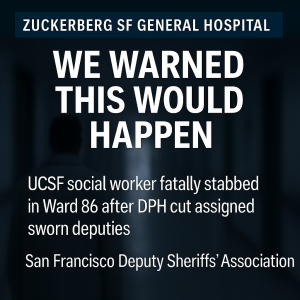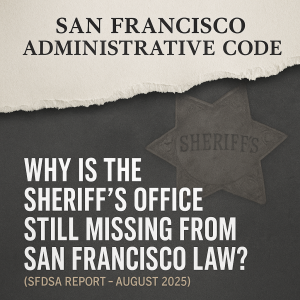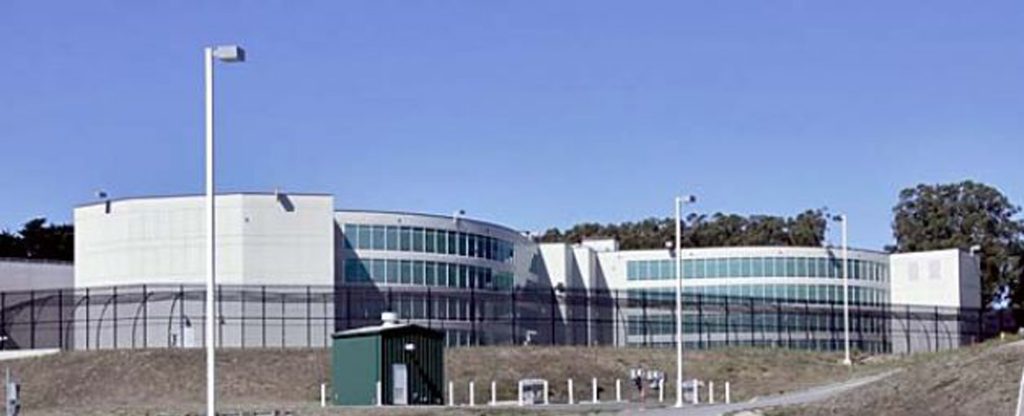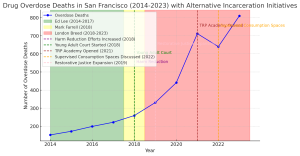FOR IMMEDIATE RELEASE
Internal DPH Memos Show ZSFGH Security Plan Was Built to Keep Deputies Out
Deputy Sheriffs’ Association says DPH cut sworn staffing, misused equity data, and spent more on an unproven BERT / private-security model before fatal stabbing of UCSF social worker
San Francisco, CA — The San Francisco Deputy Sheriffs’ Association (SFDSA) is releasing internal Department of Public Health (DPH) documents showing that security changes at Zuckerberg San Francisco General Hospital (ZSF GH) were deliberately structured to keep law enforcement out of most patient crises — even as weapons seizures, assaults, and workplace-violence incidents remained high.
On December 4, 2025, a UCSF social worker was fatally stabbed multiple times in Ward 86 at ZSF GH. A nearby deputy intervened, disarmed the attacker, and allowed staff to begin life-saving measures, but the victim later died. SFDSA President Ken Lomba says this tragedy is the predictable outcome of a policy that treated deputies as a problem to be reduced, not a safety partner to be strengthened.
“DPH used the language of ‘equity’ and ‘best practices’ to justify a security experiment that removed deputies from high-risk units and posts and replaced them with BERT clinicians, cadets, and unarmed guards,” said Lomba. “Their own memos brag that almost nine out of ten behavioral emergencies now happen with no law enforcement present. On Ward 86, we saw the real-world result of that decision.”
DPH’s own memos: cut deputies, keep them out of the room
 In a June 14, 2021 Safety Services Staffing Plan Proposal, DPH proposed to:
In a June 14, 2021 Safety Services Staffing Plan Proposal, DPH proposed to:
- Reduce Sheriff’s deputies at ZSF GH by 11.4 positions (about 14.5 FTE including backfill), and
- Add 31.9 FTE of Psychiatry Nurses and Licensed Psychiatric Technicians, plus 2.5 FTE Care Experience Health Workers, to form a Behavioral Emergency Response Team (BERT).
The same plan specifies that non-uniformed cadets would provide clinical support in patient intervention, function as “healthcare ambassadors,” and conduct campus patrols.
A later August 28, 2023 Security Staffing Plan Update to the Health Commission reports that:
- The plan would reduce deputies by 11.4 FTE and add 29.4 FTE of BERT staff to create a 24-hour BERT program in the Emergency Department.
- DPH proposed supporting BERT with non-uniformed cadets trained as “healthcare ambassadors,” not with additional deputies.
- By early 2023, BERT was fully implemented and, instead of calling law enforcement, staff were calling BERT to thousands more “risk behavior” events than the Sheriff’s Office, with over 80% of BERT activations — and nearly 90% of Emergency Department BERT activations — occurring without any law enforcement present.
- In July 2023, the 11.4 FTE of deputies was officially removed from the ZSFGH work order, reducing deputies from 30 FTE to 21 FTE.
At the same time, the update memo notes that 46.5 FTE of “healthcare trained private security officers” were installed as hospital ambassadors at ZSFGH campus entry points.
“At the one campus that handles most of San Francisco’s stabbings, shootings, and psychiatric emergencies, DPH chose to send BERT and cadets into the room and push sworn deputies farther away,” Lomba said. “That is not a co-responder model — that’s a model designed to keep law enforcement out of the picture until after violence has already occurred.”
An expensive experiment, not a safety upgrade
DPH has sometimes framed these changes as modernization or rationalization of security. Their own FTE and cost figures tell a different story.
According to DPH’s Safety Services plan and subsequent updates:
- At ZSFGH, DPH proposed to reduce the Sheriff work order by 11.4 deputy positions (about 14.5 FTE), while adding 31.9 FTE of BERT psych nurses/techs and 2.5 FTE care workers.
- By August 2023, 29.4 FTE of BERT positions were funded, and 46.5 FTE of contracted “healthcare trained private security officers” were in place at ZSFGH campus entry points.
- In their own cost comparisons, DPH shows that a small number of deputies and cadets account for several million dollars in annual cost, while dozens of private security officers are added on separate contracts, illustrating that DPH shifted money away from sworn and cadet roles toward a much larger private-security footprint.
At Laguna Honda Hospital, DPH’s example of “efficiency” makes the trade-off clear:
- 8.4 FTE of deputies cost significantly more than 34.6 FTE of private security officers, who were then used to provide 24-hour monitoring in multiple locations.
Taken together, these documents show that DPH did not simply “save money by replacing deputies.” The department reduced sworn coverage and then layered on:
- Dozens of BERT clinical positions,
- Dozens of contracted private security officers, and
- Cadets or other non-sworn “ambassador”-type roles.
From SFDSA’s perspective, this amounts to an expensive and unproven security experiment: one that trades sworn patrol and rapid response for a more complicated mix of clinical teams and unarmed guards, while leaving fewer deputies immediately available when violence erupts.
The Association is calling on the City to disclose the full annual cost of the BERT-plus-private-security model at ZSFGH and explain why that funding was not instead used to fully staff a sworn patrol division and fixed-post deputies in the highest-risk units and posts at the hospital.
Misusing equity data to justify cutting deputies
DPH also relied on a single statistic to justify reducing deputies: that about 46% of use-of-force incidents against patients in one reporting period involved Black/African American patients.
SFDSA does not dispute that racial disparities are real and serious. However, the way the data are presented raises concerns:
- The figures in DPH’s materials do not provide the racial breakdown of patients in the specific high-risk areas (ED, PES, inpatient psych) where most force is recorded.
- The same Safety Services plan acknowledges that deputies assisting with patient restraints and defending staff against attacks drive a large share of force incidents, yet this context is not clearly presented when the “46% Black” figure is cited.
Despite these limitations, DPH used this disparity as one of the key reasons to reduce the Sheriff’s work order and expand BERT and non-sworn roles.
“If DPH truly wants equity, the answer is not to quietly pull deputies out of high-risk units and hope the numbers look better,” Lomba said. “The answer is to be honest about what is driving these incidents and to fix it in partnership with staff, patients, and the communities we serve.”
ZSFGH is not comparable to LA or Alameda
In its own Security Model responses, DPH repeatedly cites Alameda Health System and Los Angeles County hospitals as “comparable” to ZSF GH and as justification for its hybrid BERT / non-sworn model.
SFDSA believes this comparison is misleading:
- One overloaded campus vs. multi-hospital systems
- Alameda and LA counties distribute trauma and psychiatric emergencies across multiple hospitals and trauma centers, with sheriff’s deputies and city police departments available to surge to calls.
- San Francisco relies on one safety-net campus — ZSFGH — as the City’s only Level-1 trauma center and only 24/7 psychiatric emergency department for roughly 1.5 million people in San Francisco and northern San Mateo County.
- Co-responder vs. “keep deputies away”
- DPH’s own descriptions of Alameda and LA highlight hybrid security models that include healthcare security officers and county sheriff’s deputies as partners.
- At ZSF GH, by contrast, DPH cut deputies by roughly one-third and used BERT plus cadets and unarmed private security to handle most risk-behavior incidents, with success measured partly by how often law enforcement is not present.
- Existing record of violence at ZSF GH
- ZSFGH’s own annual reports emphasize that healthcare workers are almost four times more likely than workers in most other industries to experience workplace violence and that the hospital has had to invest in BERT and security upgrades to address persistent safety issues.
Not just one building — a vertical city of high-risk patients
Not just one building — a vertical city of high-risk patients
When DPH reduced deputy positions at ZSFGH, they did not simply pull deputies off “one hospital building.” They thinned coverage across what is effectively a vertical city of high-risk patients.ZSFGH is a dense hilltop campus made up of multiple multi-story towers and specialty buildings — trauma, medical-surgical units, HIV and infectious-disease clinics, psychiatric emergency, acute psych, and high-risk outpatient programs — all stacked on top of each other and connected by elevators, stairwells, skyways, and long interior corridors. Nearly all of San Francisco’s Level-1 trauma care, 24/7 psychiatric emergency, and safety-net inpatient care is concentrated on this single site.
When a call comes in from an upper floor or a remote ward, deputies have to navigate multiple floors, secured access points, and crowded hallways before ever reaching the scene. On a campus like that, “response-only” policing is not a theory problem, it is a time-and-distance problem: every minute of delay is more time for a stabbing, a strangulation, or an assault on staff to continue.
Cutting deputies in that environment does not just mean fewer uniforms in one lobby. It means fewer sworn officers available to cover an entire vertical grid of vulnerable units — from the Emergency Department to Ward 86 to psych and ICU floors — at the same time. That is the reality DPH chose to ignore when it redesigned security around BERT, cadets, and unarmed guards.
“You cannot treat a single, overloaded trauma and psych emergency hospital in San Francisco like just another line on a spreadsheet next to Alameda and LA,” Lomba said. “Those systems built co-responder models with deputies and clinicians together. DPH’s implementation at ZSFGH went in a different direction: fewer deputies, more complexity, and more distance between sworn officers and the highest-risk units.”
What SFDSA is demanding now
In light of the internal memos, equity data, cost figures, and the fatal Ward 86 stabbing, SFDSA is calling for:
- Immediate restoration and expansion of assigned deputy-sheriff posts on high-risk units and posts at ZSFGH, including Ward 86, ED, PES, and critical inpatient floors, with a fully staffed sworn patrol presence on campus.
- An independent safety and equity audit of ZSFGH’s security model — including BERT, cadets, private security, and deputy staffing — with full participation from frontline unions representing deputies, nurses, physicians, social workers, and other hospital staff.
- Transparent incident reporting, including detailed breakdowns of workplace-violence events and use-of-force by unit, incident type (crime-related, psychiatric, medical), clinical factors, and who requested the response, so that decisions are based on full context rather than partial statistics.
- A true co-responder model, where BERT clinicians work with trained, equipped deputies on the most dangerous calls, rather than being sent in instead of law enforcement.
“These memos show that the stakes at ZSFGH were always high: concentrated trauma, psychiatric emergencies, and a vulnerable patient population,” Lomba said. “What changed was DPH’s decision to move deputies out of the way and measure success by keeping law enforcement out of the room. After this tragedy, the City cannot pretend that model is working.”
Media Contact
San Francisco Deputy Sheriffs’ Association
Phone: (415) 696-2428









